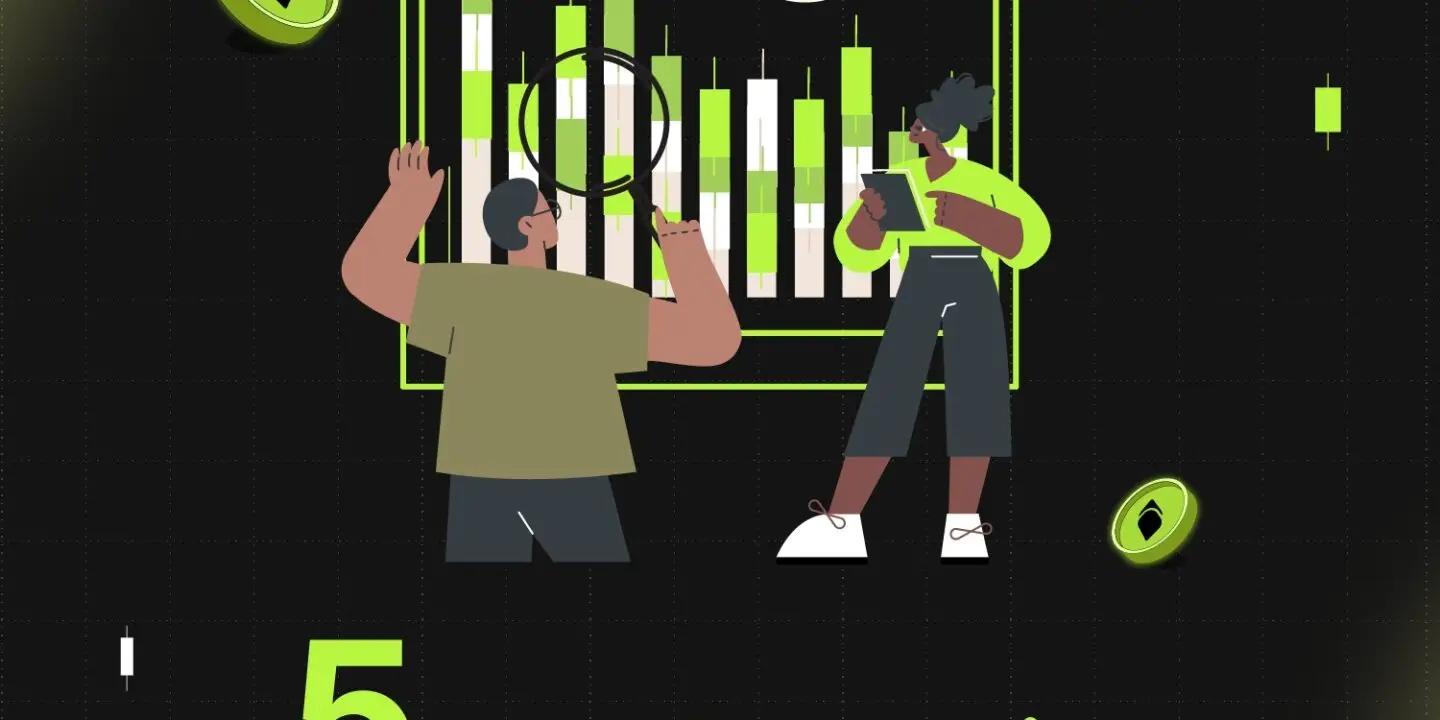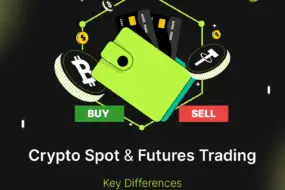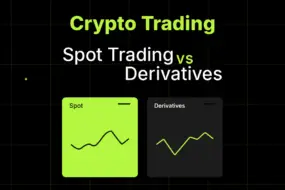
Crypto futures trading has become a popular instrument allowing anyone to buy and sell cryptocurrencies without having to own the asset. While spot trading enables you to buy and sell assets, futures contracts allow you to place a trade contract by going long or short on an asset with a small margin.
What sets futures apart from spot is the opportunity to take leverage and increase the contract size. By using leverage, you can increase your profit potential. It is important to remember that futures trading is a high risk-high reward instrument, hence, having a well-defined trading strategy is essential. For futures trading, especially in the volatile world of crypto, for several key reasons:
Mitigating Risks & Becoming Disciplined
Futures trading, particularly in the crypto market, involves high levels of risk due to the volatile price movements of cryptocurrencies. Without a clear strategy, traders can easily fall into emotional trading—making impulsive decisions that lead to significant losses. A trading strategy helps set rules for when to enter and exit trades, how much to invest, and when to take profits or cut losses, reducing the emotional aspect of trading.
One of the biggest challenges traders face is maintaining consistency. A solid trading strategy allows traders to follow a structured approach to trading, eliminating guesswork and emotional decisions.
Optimising Profits & Adapting to Market Conditions
A good trading strategy is designed to capitalize on specific market conditions, whether it’s a trending market, range-bound conditions, or breakouts. By following a tested and refined strategy, traders can improve their chances of success by entering trades with a higher probability of profitability.
Strategies also help maximize profits by ensuring that traders only participate in the market when conditions are favorable.
Effective Risk Management & Improving Decision-Making
Futures trading often involves leverage, meaning you can control a large position with a small amount of capital. While this can amplify profits, it also magnifies losses. A solid trading strategy incorporates risk management techniques, such as setting stop-loss orders, limiting the use of leverage, and defining risk/reward ratios for each trade.
Optimizing your trade strategy will help simplify your decision-making by providing clear guidelines on what signals to look for and how to respond when the market moves in a specific direction.
5 Popular Crypto Futures Trading Strategies
Trend Following Strategy
The Trend Following Strategy is one of the simplest and most effective approaches to trading crypto futures. The basic premise is that “the trend is your friend.”
In this strategy, traders aim to capitalize on the continuation of an existing trend — whether bullish or bearish. By identifying and following established trends, you can ride the momentum and make trades in the direction the market is moving.
Key Steps
- Identify the trend: Use tools like moving averages (50-day, 200-day), the Average Directional Index (ADX), or trendlines to confirm the market direction.
- Confirm the trend: Cross-referencing with volume indicators or other technical tools can provide additional validation for the strength of the trend.
- Enter the market: Enter a long position in an uptrend or a short position in a downtrend.
- Stop-loss management: Place stop-loss orders just outside key support or resistance levels to protect against sudden trend reversals.
Example of Trend Following Strategy
Suppose Bitcoin (BTC) is trading at $30,000, and it has been consistently increasing for several days, forming a clear upward trend. The 50-day moving average crosses above the 200-day moving average, confirming a bullish trend (often called the “Golden Cross”).
A trend-following trader would enter a long position (buying futures contracts), expecting the price to continue rising. They might place a stop-loss order just below the previous low at $29,000 to manage risk.
If the uptrend continues and Bitcoin reaches $35,000, the trader could either exit the position to lock in profits or adjust their stop-loss higher to protect gains while staying in the trade.
Why it works?
Crypto markets are highly volatile, and trends tend to be more pronounced than in traditional financial markets. Trend following capitalizes on strong market movements, which often occur after significant news or market sentiment shifts.
Scalping Strategy
Scalping is a short-term, high-frequency trading strategy aimed at capturing small price fluctuations. Scalpers execute dozens or even hundreds of trades within a day, aiming to profit from tiny price changes. The strategy requires precision, a deep understanding of market behavior, and quick decision-making skills.
Key Steps
- Use of low timeframes: Scalpers typically trade on 1-minute, 5-minute, or 15-minute charts.
- High liquidity pairs: Focus on crypto futures pairs with high liquidity like Bitcoin (BTC) or Ethereum (ETH) to ensure tight spreads and quick trade execution.
- Automated tools: Many scalpers use bots or automated trading platforms to execute orders in rapid succession.
- Risk management: Because profits are small per trade, scalping relies on volume. Tight stop-losses and disciplined position sizing are crucial to mitigate risks.
Example of Scalping Strategy
Imagine you’re trading Ethereum (ETH) futures on a 1-minute chart. The price fluctuates between $1,950 and $1,955, creating a narrow price range. Essentially , a scalper will enter a trade as soon as the price touches the lower Bollinger Band (expecting a short-term rebound), aiming to exit just as it reaches the upper Bollinger Band.
Why it works?
In a volatile market like crypto, price fluctuations happen frequently throughout the day. Scalping allows traders to exploit these small, frequent changes while keeping exposure to the market minimal, which reduces the chance of large losses.
Range Trading Strategy
Range trading involves identifying support and resistance levels and making trades within these established price boundaries. Unlike trend-following, range traders assume the market will continue to move sideways without breaking out.
Key Steps
- Identify key support and resistance levels: Use technical tools such as horizontal lines, Fibonacci retracement levels, and pivot points.
- Enter trades at the extremes: Go long when the price hits the support level and short when the price touches resistance.
- Risk management: Place stop-losses slightly outside the identified range to protect against unexpected breakouts.
- Take profits early: Because the market is moving sideways, it’s essential to take profits near support and resistance levels to avoid missing out on potential reversals.
Example of Range Trading Strategy
Let’s say Litecoin (LTC) is trading in a range between $100 (support) and $110 (resistance). A range trader would go long (buy) when the price hits $100, expecting it to rise back toward $110. Conversely, they would go short (sell) when it approaches $110, anticipating a decline back to $100.
In this example, the trader might also place a stop-loss order just below the support level at $98 in case the price breaks below the range and doesn’t reverse as expected.
Why it works?
Range-bound markets are common, especially during periods of consolidation. By trading between known levels of support and resistance, you can capitalize on price stagnation and avoid the risks of trading in a trending or highly volatile market.
Breakout Trading Strategy
The Breakout Trading Strategy is designed to capture the initial price movement when a crypto asset breaks out from a range or pattern, such as a triangle or channel. Breakouts often lead to significant price movements, making this strategy ideal for futures traders looking for larger profits.
Key Steps
- Identify a pattern: Use chart patterns like triangles, flags, or ranges where price is trading within a confined space.
- Set up breakout levels: Define your breakout levels just beyond the resistance for upward breakouts or below the support for downward breakouts.
- Volume confirmation: Ensure the breakout is supported by a surge in trading volume, indicating that it’s not a false breakout.
- Risk management: Place stop-losses just below the breakout level to minimize losses if the price reverses.
Example of Breakout Trading Strategy
Suppose Ripple (XRP) has been consolidating in a symmetrical triangle pattern between $0.45 and $0.50, with lower highs and higher lows. The price is nearing the apex of the triangle, and the trader is waiting for a breakout. When the price breaks above $0.50 with a surge in volume, the trader enters a long position, anticipating a significant move higher.
To manage risk, the trader places a stop-loss just below the breakout level, say at $0.48, in case it turns out to be a false breakout. If the breakout is successful, and XRP rallies to $0.55, the trader takes profit or trails their stop-loss to lock in gains.
Why it works?
Crypto markets often go through periods of low volatility followed by sharp price moves. Breakout traders can position themselves to take advantage of these explosive moves, either going long after an upward breakout or short after a downward breakout.
Leverage and Risk Management Strategy
Effective leverage and risk management is less of a “trading strategy” and more of an essential component of any crypto futures trading strategy. The use of leverage can magnify both gains and losses, so managing your risk is critical to long-term success.
Key Steps
- Choose appropriate leverage: Avoid high leverage (e.g., 50x or 100x) unless you are an experienced trader. Start with lower leverage (e.g., 3x to 10x) to reduce risk.
- Set stop-losses: Always use stop-loss orders to limit the potential downside of your trades. A well-placed stop-loss can be the difference between surviving and thriving in the crypto futures market.
- Position sizing: Never risk more than 1-2% of your trading capital on a single trade. By using proper position sizing, you can ensure that even a string of losses doesn’t wipe out your account.
- Take-profit orders: Use take-profit orders to lock in gains, especially when trading highly volatile assets.
Example of Leverage and Risk Management Strategy
A trader might enter a Bitcoin futures trade with 5x leverage when the price is at $40,000. They plan to risk only 1% of their total trading capital ($1,000 of a $100,000 account) on this trade. With leverage, they control a position worth $200,000 (5x the capital allocated).
The trader places a stop-loss at $39,500 to limit potential losses to $1,000. If the trade goes as expected, and Bitcoin rises to $41,000, the trader makes a profit, having successfully managed risk by using leverage cautiously and setting clear stop-losses.
Why it works?
The crypto market is notorious for its unpredictability. Proper leverage and risk management prevent you from getting overexposed to the market’s volatility and allow you to trade with confidence, knowing that even if a trade goes wrong, it won’t be devastating to your portfolio.
Conclusion
Crypto futures trading offers tremendous profit potential, but it comes with significant risks. To succeed in this highly volatile market, traders need well-defined strategies and disciplined execution.
Remember that each strategy works best in specific market conditions, so adapt your approach as needed based on the prevailing market environment. By incorporating the above strategies, you can enhance your trading skills and increase your chances of success in crypto futures trading.











